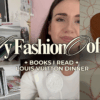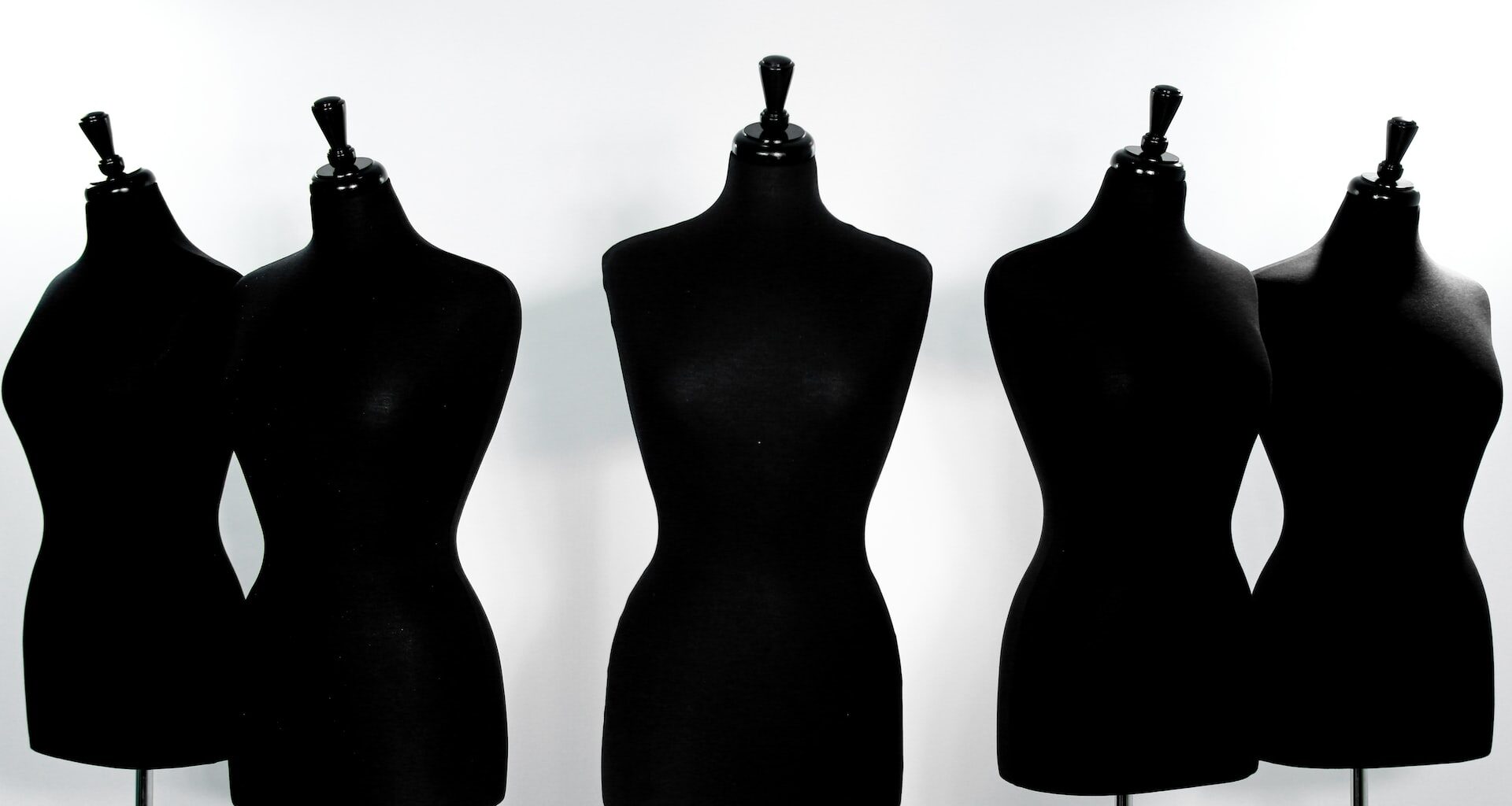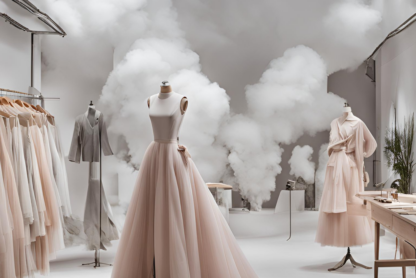Are you an (aspiring) fashion designer, product developer, editor, buyer, or other professional who needs to be often in touch with the products?
Or you are a fashion enthusiast and you love watching fashion shows?
No matter your connection to fashion, whether you are a fashion professional or someone passionate about the industry, you need to know these 20 popular fashion design terms.
Fashion is a language, and clothes are, naturally, one of the main points of conversation. But the thing is, when we talk about fashion collections and products, industry insiders usually don’t only use simple terms like “dress” or “pants”; they use terms to refer to specific design techniques and silhouettes. You’ve probably noticed it when you read runway reviews, watch/attend fashion conferences, or have a conversation with your fellow fashion colleagues, boss, and recruiters. Therefore, it’s useful to speak the proper vocabulary and recognize the different terms when you read or hear about them.
In this article, we navigate you through 20 common fashion design terms.
Seen On The Runway: 20 Popular Fashion Design Terms
Appliqué
“Appliqué” comes from the French word “appliquer”, which means “to apply”. It is a sewing technique that consists of applying one material on top of another. This is done to embellish the garment and give an extra dimension to the fabric. The small pieces of fabric are cut into different shapes. Then, these are attached to a larger piece of cloth to form a pattern.
Appliqué materials are usually sewn in by hand or can be applied using a sewing machine. The raw edges are turned under or covered with decorative stitching.
The appliqué technique can be used on a variety of clothes. It is especially preferred in couture and ready-to-wear gowns to create unique pieces with contrasting motifs, patterns, and textures.
Bolero
In fashion, the term “bolero” refers to a short, cropped jacket that stops just above the waist. It is collarless, open-fronted (though it can be fastened as well), and covers the back and the arm.
The bolero jacket originated, like the music, from Spain. Before the 19th century, it was more commonly referred to as a “Zouave”, which was influenced by military uniforms.
It wasn’t long before the Zouave jacket made its way into non-military fashion. Then, it became a fashionable item among the ladies in the mid-19th century. The design often featured distinctive embroidery, trimmings, and embellishments.
Toward the mid-20th century, the bolero jacket was taken up in women’s fashion again. Also, it was worn over evening gowns, bridal dresses, and tops. Yves Saint Laurent was a designer particularly interested in the bolero, introducing it in the 1980s. Nowadays, it is common to see a bolero on the runway, from Ready-to-wear to Couture.
Brocade
Brocade is a type of thick and rather heavy fabric where patterns are woven into it by using the jacquard technique. Also, it’s traditionally made of silk. Now, it’s possible to find brocade garments made of satin, velvet, cotton, wool, damask, tapestry, and even synthetic fibers. It doesn’t make the material look less sophisticated though as brocade elevates any type of outfit.
There are different types of brocades: continuous, discontinuous, imperial, brocatelle, etc. Brocade weaves vary widely in complexity. Most simple brocade patterns consist of a single color, while complex brocade patterns use multiple colors – silver and gold being among the popular options.
In fashion, brocade is commonly used in dresses, trousers, jackets, and suits, both in formal, semi-formal, and informal wear, although traditionally it has been used for other purposes as well.
Brocade has a long history, and it has been used in various cultures.
The first historical records trace its origins in China because the material traditionally relied on the nation’s silk trade. Then, as silk production began in the Byzantine Empire, brocade became popular among the European nobility throughout the Middle Ages. Also, it was used during the Renaissance as a default material for draperies and upholstery. During the Victoria era, it was used in women’s clothing. Brocade was a luxurious garment made from expensive silk. Therefore, only the wealthiest members of society were able to purchase it.
Because it was used mostly in home decor back in the day, brocade was a stiff fabric made entirely by hand. However, with the invention of the Jacquard loom in the early 19th century, the production process became much quicker and more efficient. Now, it is possible to create more complex brocade patterns. This simplified technique made brocade lose its association with the upper class only and became available to the masses.
Empire line
Empire-line dress drapes down from the chest. This silhouette aims to draw attention to the line above the natural waist. It aims to create a lengthening effect and make the wearer look taller and slimmer.
“Empire Line” takes its name from Empress Joséphine de Beauharnais. She is the spouse of Napoléon Bonaparte, leader of the First French Empire. She popularized the silhouette, which became known as an “empire-style waist” in late eighteenth-century Europe, the Neoclassical era. At that time, Greek and Roman culture became increasingly popular, and consequently – women were appealed to the long drapey dresses. They offered a more comfortable alternative compared to the corset. Also, this meant to shift the attention from the waist, which was very sexualized at the time, to below the bust area, suggesting that this part can be as feminine as the waist. The Empire silhouette was also popular at the beginning of the 19th century.
Epaulet
An epaulette (also spelled “epaulet”, which comes from the French word “little shoulder”) is a decorative shoulder adornment that can come with stripes and fringe.
Traditionally, epaulettes were used on military uniforms to indicate military rank and protect the shoulders from sabers. Some armies still use it as part of their parade uniforms. In modern fashion, epaulets are used especially on blazers and trench coats.
Frog fastenings
Frog Fastenings are ornamental braidings used to fasten the front of a garment. They consist of a button on one side with a loop to pass through on the other. They can also be used for purely decorative purposes.
Frog fastenings are sometimes referred to as a ‘Chinese frog.’ They date all the way back to Ancient China where they were used on traditional Chinese clothing. They were also employed in military uniforms in the 17th and 19th centuries. It was then that this decorative technique became known as ‘frogging’.
Nowadays, frog fastenings are used mainly for solely decorative purposes by designers like Balmain and Jean Paul Gaultier, among others.
Herringbone
Herringbone refers to a chevron pattern, with a “V” shape in zigzags that reverse every few rows by alternating colors in each direction. This pattern looks similar to the herringbone’s skeleton – hence the name.
As you can see, it’s rather about the specific type of weave rather than the fabric itself. In fact, herringbone can be made from different fabrics, although the most common are cotton, wool, and tweed.
For a little history, the herringbone patterning was first used to build roads in ancient Rome. The interlocking paving structure allowed for the compression of traffic, making roads very stable and durable. Later, herringbone’s interesting pattern made its way into classic men’s tailoring. Now, it’s used a lot on suits and coats, but you can find it on other items occasionally as well. We can also see many herringbone designs in high fashion on the runway.
Jacquard
Jacquard is a textured fabric that is recognizable by complex patterns woven into it. It doesn’t involve techniques like printing, dyeing, or embroidering.
This fabric is defined by the weave – not the material it is made from. In fact, a jacquard can be created from any material, like silk, linen, or cotton.
The term was inspired by the French textile artisan Joseph Marie Jacquard who invented his namesake loom in 1804. He worked as a “draw boy”, a name given to the children who were required to climb on top of the looms and move the threads following a specific pattern. This work done by hand was very dangerous and time-consuming. Since this type of fabric was expensive to produce, only the wealthiest members of society could afford it.
Joseph Marie Jacquard decided to find a better solution for creating jacquard fabrics. He invented an automated process. A machine that used a series of punch cards, rather than a draw boy, to guide the loom. It instructed which threads to raise at a specific time to create a jacquard weave.
Today, modern fashion designers use electric looms, and because the process of creating jacquard weaves has become automated and fast, it allows them to produce bigger quantities of items made of jacquard. The formerly expensive fabric is now available to the masses and is used not only to produce clothes, but also furniture, linens, and home décor.
Mermaid Silhouette
As the title suggests, the mermaid dress is a gown in the shape of a mermaid that embraces the chest and the waist down to the hips and thighs, creating an hourglass silhouette that finishes at the bottom in the shape of a fish tale.
The mermaid silhouette is especially common in wedding and evening wear, and couture collections due to their elegant and glamorous style. Satin, taffeta, and silk are among the most popular choices of fabrics.
Mermaid gowns emerged in the late 19th century when it was popular to wear corsets and accentuate curves. The style was later popularized in the 1930s by the French designer Marcel Rochas, who introduced the mermaid line to the Haute Couture catwalks. In its September 1950 issue, Vogue published a famous picture shot by Irving Penn of his spouse – the Swedish model Lisa Fonssagrives-Penn – wearing a mermaid gown. This picture skyrocketed the mermaid line’s popularity and became a beloved garment of Hollywood actresses.
Passementerie Edging
The term “passementerie edging”, from the French word “passement”, refers to ornamental edging and trims.
There are different kinds of passementerie trimmings: braids, cords, laces, fringes, tassels, and metallic beading. They all have different purposes. Some passementerie trimmings are used to prevent cords from unraveling and tie back curtains, while others serve for purely ornamental purposes, which is the most common use of passementerie edging.
Nowadays, the modern use of passementerie is frequently found in haute couture as a form of elevating garments by adding embellishments.
Patchwork
Patchwork is a technique that consists of attaching pre-cut pieces of fabric and sewing them together to form one large design. These pieces can have mixed patterns, colors, and textures.
Patchwork can be mistaken for quilting. The difference is that the quilting technique consists of stitching two or more layers of fabric that are padded in appearance, and they are sewn together with lines of stitching. While the layer that has been created by combining multiple fabrics together is called patchwork.
Patchwork is also not to be confused with designs that have multiple prints and colors on one garment. They are not extra pieces of fabric, contrary to patchwork, but prints that are part of a single fabric. So you have to search for several pieces of cloth that were stitched together to identify a patchwork design.
Peek-A-Boo
The term “Peek-A-Boo” refers to any part of a garment that has been cut to reveal skin. It usually takes the form of cutouts on different parts of the body.
Last year, a new trend was spotted: The Peek-a-Boo bra, which consists of partly revealing the bra. Think of peek-a-boo as something more suggestive than completely exposing. This fresh take on showing the lingerie is not to be confused with the sheer, see-through looks.
Peter Pan collar
A Peter Pan collar is a flat collar that lies upon the torso with soft, curved corners.
It first became popular in France when the famous French author Colette published the book “Claudine à l’école” (“Claudine at School”) in 1900, which told the story of a teenage girl named Claudine and her adventures in secondary school. It was a tremendous success and became a trend among the ladies and little girls in France, who referred to it (and still do) as “le col Claudine” (the Claudine collar).
In 1905, a very similar type of collar was designed by John White Alexander and worn by Maude Adams in the Peter Pan Broadway play.
Today, the Peter Pan collar remains a timeless neckline design, used on many kinds of dresses, shirts, and blouses.
Fun fact: many famous witches of pop culture have dresses with Peter Pan collars. You have probably seen them on characters like Wednesday Addams or Sabrina Spellman.
Plaid
The term “plaid” is used to describe a crisscross pattern made of intersecting horizontal and vertical bands or stripes in multiple colors, as shown in the image above.
It is often interchangeable with the words “tartan” and “check”, and though they are closely linked, they are not quite the same.
Originally, “plaid” was referred to as “tartan”, the name given by the Scottish to a fabric used to create the highland dress – the tartan kilt worn by Scottish men. Traditionally, “tartan” was mostly made from wool, while plaid can be made from different fabrics – wool but also cotton, flannel, etc. Nowadays, designs with the tartan pattern are commonly called “plaids” or “checks”.
Princess line
A “princess line” describes a garment that is cut in long panels (or “princess seams”) to shape the body, without horizontal joining seams or any separation at the waist.
This silhouette was introduced by Charles Frederick Worth in the 1870s, who named it after Princess Alexandra of Denmark.
The princess line was used in Christian Dior’s 1951 collection called “Ligne Longue”. Traditionally associated with dresses, today this silhouette can also be found in other types of garments, like jackets, blouses, and coats.
Raglan
A Raglan Sleeve is a sleeve with a long, diagonal seam that runs from the armpit to the neck. Fun fact: it was named after First Baron Raglan, Lord Fitzroy Somerset, Commander-in-Chief, who lost his arm during the Crimean War.
Contrary to the common set-in sleeves that use a seam from the armpit to the shoulder, raglan sleeves have a wider underarm fitting. The length of the raglan sleeve can be short, long, or three-quarters. Because the wider underarm area offers greater ease of movement, raglan sleeves are especially preferred in sportswear, for example in pullover sweaters, hoodies, and sweatshirts.
The style actually gained popularity when baseball teams began to use raglan sleeves in their uniform design. Because of this, you can see shirts with raglan sleeves called “baseball tees.” However, raglan sleeves are not used exclusively in sportswear, and you can see them across any ready-to-wear and even in Haute Couture shows.
Revers
“Revers” is derived from the same French word, meaning “reverse” or “turned back.” It is a part of a garment – typically a collar or cuffs – that is folded back/reversed (hence the name) to reveal the lining.
A stylish element in garment construction, the revers is used for decorative purposes or to achieve a contrasting effect with the main fabric, which can have a distinct pattern or color, or be made from a different material.
Revers is not to be confused with a classic revere collar, which can be found on blouses and shirts. The latter also creates a V-shaped neckline but will usually display the same color at the underside of the garment.
Ruching
Ruching is a sewing technique that gathers the fabric along parallel lines, creating a series of soft folds and wrinkles. It creates a textured, often elasticized effect that adds dimension and an extra stylish effect to the fabric.
Ruching is commonly used in dresses, blouses, and swimwear so you will notice it this summer. It is also a popular technique in home decor.
Pay attention that ruching is not the same as pleating. Ruching gathers the fabric into generally irregular folds, while pleating folds the fabric into even, consistent pleats, creating a repetitive pattern. The pleats are then pressed or stitched to maintain their shape and give structure to the garment.
Toile de Jouy
Jouy print, also known as “Toile de Jouy, is a type of fabric characterized by a repeated pattern depicting a scene, printed onto a plain white or off-white background.
The pattern typically comes in a single color, most commonly black, red, and blue, although you can find variations in other colors.
Toile de Jouy, also called “Toile”, originated in the 18th century in Jouy-en-Josas, a town near Versailles, France, hence the name. The term “Toile” refers to a specific type of linen that was produced in the Jouy-en-Josas textile factory, opened in 1760 by German entrepreneur Christophe-Philippe Oberkampf. His designs were initially printed from woodblocks and then, starting in 1770, from copper plates.
Even though the printed fabric originated in Ireland in the 18th century, it was Oberkampf’s textile manufactory that was one of the first major producers of Toile, which eventually spread across the rest of Europe, and the one that gave the name “Toile de Jouy”.
The term “Toile” later evolved, referring not only to linen cloth but also to the design aesthetic characterized by repeated patterns. In the 18th century, Toile de Jouy often depicted romanticized scenes of countryside life, mythological tales and creatures, and historical events. Nowadays, the Jouy pattern can feature all kinds of scenes with landscapes and figures, but the pastoral aesthetic remains a classic.
Toile de Jouy’s timeless appeal has ensured its enduring popularity among modern designers. You can sometimes spot the Jouy print on the runway.
Tuck
In sewing, a tuck (not to be confused with a pleat) is a narrow fold of fabric that is sewn or fastened in place, vertically or horizontally. Tucks can be found on different kinds of garments – from shirts to blouses and dresses, both in men’s and women’s fashion.
The small pleats formed by tucks add a decorative element to the garment, shape the silhouette, and emphasize the desired areas of the body by adding some volume. They can also be used to shorten a finished garment.
Want to learn more fashion terms? You can download our free PDF “30 fashion industry terms” and read our guide about textiles.
Follow us on Instagram for more updates!






